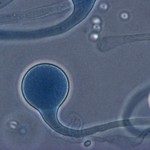Lien vers Pubmed [PMID] – 35412354
Lien DOI – 10.1128/aac.01725-21
Antimicrob Agents Chemother 2022 May; 66(5): e0172521
Since echinocandins are recommended as first line therapy for invasive candidiasis, detection of resistance, mainly due to alteration in FKS protein, is of main interest. EUCAST AFST recommends testing both MIC of anidulafungin and micafungin, and breakpoints (BPs) have been proposed to detect echinocandin-resistant isolates. We analyzed MIC distribution for all three available echinocandins of 2,787 clinical yeast isolates corresponding to 5 common and 16 rare yeast species, using the standardized EUCAST method for anidulafungin and modified for caspofungin and micafungin (AM3-MIC). In our database, 64 isolates of common pathogenic species were resistant to anidulafungin, according to the EUCAST BP, and/or to caspofungin, using our previously published threshold (AM3-MIC ≥ 0.5 mg/L). Among these 64 isolates, 50 exhibited 21 different FKS mutations. We analyzed the capacity of caspofungin AM3-MIC and anidulafungin MIC determination in detecting isolates with FKS mutation. They were always identified using caspofungin AM3-MIC and the local threshold while some isolates were misclassified using anidulafungin MIC and EUCAST threshold. However, both methods misclassified four wild-type C. glabrata as resistant. Based on a large data set from a single center, the use of AM3-MIC testing for caspofungin looks promising in identifying non-wild-type C. albicans, C. tropicalis and P. kudiravzevii isolates, but additional multicenter comparison is mandatory to conclude on the possible superiority of AM3-MIC testing compared to the EUCAST method.





